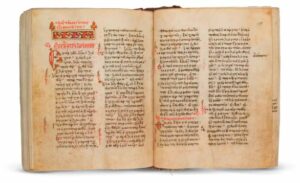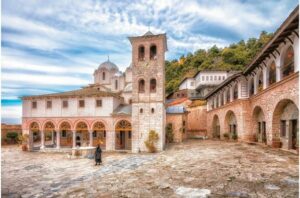A 10th-century Gospel manuscript has been returned to Greece from the Museum of the Bible after it was identified among hundreds of items looted from the Greek Orthodox Church during World War I. The return of the manuscript is part of a museum-wide investigation, prompted by revelations that thousands of the museum’s exhibit pieces were acquired from dubious sellers.
The manuscript
According to the Museum of the Bible’s online catalog, the manuscript in question is the Eikosiphoinissa Manuscript 220. Produced in Southern Italy around the year 1000, the manuscript contains the four Gospels written in Greek. Smithsonian Mag notes that the museum began its investigation in 2019 when religious scholar Greg Paulson identified the manuscript as possibly stolen.

Over the course of the investigation, the piece was identified by several unique inscriptions, including the letters “M.K.” written on the back cover. It has been confirmed that the M.K. is a reference to the Theotokos Eikosiphoinissa Monastery (also known as Kosinitza Monastery), from which the manuscript was stolen by Bulgarian forces in 1917.
The manuscript was acquired by the Museum of the Bible in 2011, from Christie’s Auction House. Prior to that, the manuscript had been part of an antiquarian’s private collection since 1958. Now, the museum is preparing to return the manuscript to Kosinitza Monastery this month.

Museum of the Bible
The reputation of the Museum of the Bible was marred by scandal before it ever opened. It was found that David Green, museum founder and owner of Hobby Lobby, did not perform due diligence in his acquisitions. Whether Green ignored the red flags associated with illegitimately obtained artifacts or just didn’t have the know-how to identify them, the predicament has called into question a sizable portion of the museum’s collection.

According to Smithsonian Mag, these include some 11,500 artifacts that were found to have been looted from sites in Egypt and Iraq, a rare cuneiform tablet, 13 biblical fragments on papyrus, and 5,500 more cuneiform tablets that were labeled as “ceramic tiles.” Furthermore, the museum’s collection of Dead Sea Scrolls were all found to be fakes in 2020.
more at ateleia.org



































